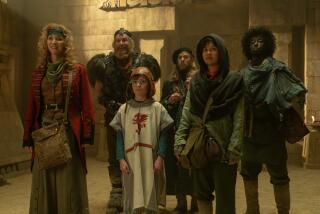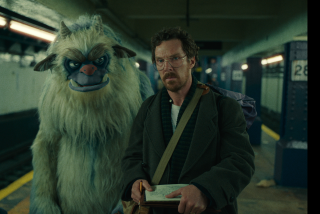Having Heroic Fun on Way to Valhalla : Terry Jones spins a wacky Viking tale
- Share via
LONDON — Stubbing out cigarettes and discarding paper coffee cups, the Vikings are on their way back to Valhalla. Lunch was over at the studio where “Eric the Viking” had been shooting. Now a dozen hairy hulks in furs, leggings, and horned helmets unsmilingly proceed to “C” stage, while the onlooking prop men and camera crew begin a litany of wisecracks:
“There’s been a lot of back-stabbing on this picture, hasn’t there?”
“Is that the only way you can carry your weapons?”
This isn’t sarcasm. Each of the surly Norseman has been impaled through the chest or belly with spear, fork, or arrow and is streaming blood. Even Terry Jones, ex-Monty Python member and writer/director of “Erik the Viking,” cracks up when one of these slain marauders looms beside him: “It always makes me laugh when I turn ‘round and see you with two axes in your head.”
Despite the gore, Jones’ movie is no celebration of pagan violence but a comic fantasy about a sensitive Viking who, accidentally having killed the woman he loves, decides (says the film’s publicity) “there is more to life than rape and pillage.” The $15 million movie--shot in Malta, in a Norwegian fjord and at studios near here--is now in post production. It’s scheduled for a mid-summer release by Orion Pictures.
Played by Tim Robbins (“Bull Durham’s” dumb ace pitcher), Erik leads his motley band--including Sven the Berserk (Tim McInnerny), Ulf the Maddeningly Calm (Charles McKeown), Thorfinn Skull Splitter (Richard Ridings), Ivar the Boneless (John Gordon Sinclair) and Leif the Lucky, who drowns on the first day--on a voyage to end the so-called doom-laden, ice Age of Ragnorok.
The Vikings set off in their shortish long ship for Asgard, City of the Gods, encountering a mercenary businessman Halfdan (John Cleese, helping out his fellow Python). Among the cast are Mickey Rooney as Eric’s granddad; Eartha Kitt as a wise woman; classical actors Antony Sher, Imogen Stubbs and Samantha Bond as, respectively, evil blacksmith Loki, Princess Aud and Erik’s lost love Helga; Freddie Jones as a failed Christian missionary, and Jones himself as the gratingly nice king of Hy-Brasil.
“Come on, dead warriors, into position,” urged the director, prone to acting out what he wants. “Try and keep a ghostly feel to it.”
The scene shooting was at Valhalla, the hall of the heroic dead within Asgard. It was built in 10 days by production designer John Beard and his team. Wreathed in carvings of serpents, great stone pillars (actually plaster) rise up toward the lighting gantry where they support thin air; fire (the real thing) belches from a pit in the flagstones.
Nobody was being very apocalyptic, however. Drudges kneaded dough and scrubbed the floor. Kids played ancient games in the dust. Robbins, out of shot, finished his Snickers bar and demanded that Odin, Supreme Norse God and Creator, come forward to address him.
As if on cue, the flames reared up a little too high and the “gods” scattered--while a grinning special-effects man stepped in to turn down the gas. Inhaling smoke, Robbins doubled up, laughing.
“That was good. Let’s do it one more time,” said Jones. The butchered Vikings yawned and shuffled on the far side of Valhalla, waiting an eternity for their reunion with Erik.
“Erik the Viking” has been loosely adapted by 47-year-old Jones from the book of 28 stories, “The Saga of Erik the Viking” (1983), which he wrote for his young son, Bill. He has also written an academic study of Chaucer’s “The Knight’s Tale.”
Jones’ fascination with Vikings and medievalism were explored on screen in both the “Njal’s Saga” skit, from an early episode of “Monty Python’s Flying Circus,” and in the troupe’s first original feature, “Monty Python and the Holy Grail” (1974). Co-directed by Jones and Terry Gilliam, this parody of the Arthurian legends abounded in “realistic” mud, blood, and smoke, although Gilliam’s solo medieval movie, “Jabberwocky” (1977), was muddier, bloodier, and smokier.
Jones went on to direct and appear in the two subsequent Python pictures, “Life of Brian” (1979) and “The Meaning of Life” (1983). His last film, “Personal Services” (1987), a bittersweet comedy based on the life of English brothel-keeper Cynthia Payne, was made in close collaboration with its writer, David Leland. It “cleared the air” for Jones, says “Erik’s” producer, John Goldstone.
It allowed “Terry to go back to the ‘Erik’ book, after several false starts at trying to adapt it, and create a whole new story,” he added.
Jones had started writing the screenplay in 1985, but nearly abandoned it when he found it didn’t lend itself to a narrative structure for a film.
“I was about to give up when I discovered a scene, which has now become the first in the film, enabling me to discard everything else except the Dragon and the falling over the edge of the world.”
“Terry had worked it all out in a month,” continued Goldstone. “I set a price ($12 million) that I thought the picture would cost and went ‘round all the major studios, who said we’d never do it for less than $30 million. I said, ‘I think we can--we’ve done it before.’ ”
Orion, which had distributed “Life of Brian,” eventually agreed to put up half the budget for American rights; the rest was raised on the strength of presales underwritten by the Swedish Gotebank, which had co-financed “The Last Emperor” and relished “Erik’s” Nordic elements.
The disastrous and costly saga of fellow Python Gilliam’s “The Adventures of Baron Munchausen,” also made under the Python’s Prominent Features banner, had no effect on “Erik’s” financing, noted Goldstone, because the deal was already in place when the Gilliam epic careered off course.
But Goldstone admits that “the completion guarantee companies were wary of a fantasy and special-effects film directed by someone called Terry!
“It took a while to convince them that we were very organized and could deliver the film on budget and still achieve something extraordinary.” (The “Munchausen” production experienced so many difficulties that its original $25 million budget grew to more than $40 million.)
Back on the set, they were filming the reactions of Erik and his followers on meeting their fallen comrades. One goes mad with a meat cleaver. Among the legions of the dead, gangly John Gordon Sinclair (“Gregory’s Girl”) gives a coy little wave.
Culminating in a long tracking shot as Erik catches sight of Helga and tells her that he will take her back to the land of the living, the scene is sweet, sinister, and daft. When it’s over, Robbins slashes his sword through the air. “More blood,” he said, “More blood.” But he doesn’t look as if he means it.
More to Read
Only good movies
Get the Indie Focus newsletter, Mark Olsen's weekly guide to the world of cinema.
You may occasionally receive promotional content from the Los Angeles Times.










